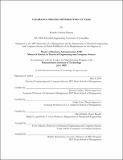Clearance pricing optimization at Zara
Author(s)
Carboni Borrasé, Rodolfo
DownloadFull printable version (3.946Mb)
Other Contributors
Leaders for Manufacturing Program.
Advisor
Jérémie Gallien and Felipe Caro.
Terms of use
Metadata
Show full item recordAbstract
In almost thirty-four years after opening the doors to its first store, the Inditex Group has grown to be one of the largest fashion distributors in the world. Today the group operates more than four thousand retail stores in seventy-three different countries and under eight different brand concepts. Inditex's Zara brand division is renown for its high degree of vertical integration that allows it to maintain a tight control over the different stages of its supply chain and endows it with the flexibility to quickly react to current fashion trends. With a yearly average of 173 new store openings, Zara's accelerated growth rate has forced it to seek innovation and continuous improvement in its operations in order to maintain the competitive advantages that characterize it. One of its biggest challenges deals with the management of its clearance sales where the remaining inventory at the end of its sales campaign must be sold at a discounted price. These clearance sales are fast-paced and pricing decisions must be made for more than 11,000 different fashion designs that Zara introduces each year, and considering the different market conditions that exist in the more than 70 countries where Zara operates. The proposed project consists in the development of a pricing mathematical model based on a sales forecasting model that estimates consumer's reactions to price discounts and a linear optimization model that makes profit-maximizing optimal price assignments. The current thesis details the design, implementation, and live test of the proposed model based pricing methodology that resulted in an approximate increase of six percent to Zara's clearance sales profits.
Description
Thesis (S.M.)--Massachusetts Institute of Technology, Dept. of Electrical Engineering and Computer Science; and, (M.B.A.)--Massachusetts Institute of Technology, Sloan School of Management; in conjunction with the Leaders for Manufacturing Program at MIT, 2009. This electronic version was submitted by the student author. The certified thesis is available in the Institute Archives and Special Collections. Cataloged from student-submitted PDF version of thesis. Includes bibliographical references (p. 110-111).
Date issued
2009Department
Leaders for Manufacturing Program at MIT; Massachusetts Institute of Technology. Department of Electrical Engineering and Computer Science; Sloan School of ManagementPublisher
Massachusetts Institute of Technology
Keywords
Electrical Engineering and Computer Science., Sloan School of Management., Leaders for Manufacturing Program.